Artificial intelligence (AI) data analytics software utilizes machine learning algorithms, natural language processing, and other AI technologies to extract insights, find patterns, and make predictions from large datasets.
These tools use AI algorithms to automate data analysis processes, eliminating the need for manual coding or extensive technical expertise. Read on to learn more about the top-rated AI data analytics tools of 2024 and discover the best AI data solution for your organization.
TABLE OF CONTENTS
Top AI Data Analytics Software and Tools Comparison
Here is a head-to-head feature comparison of the best AI data analytics software to help you discover the best solution for your organization.
| Best for | Natural language processing | Collaboration features | Starting price | |
|---|---|---|---|---|
| Salesforce Einstein Analytics Platform | CRM analytics | Yes | Good | $75 per user per month, billed annually |
| IBM Cognos Analytics | Self-service analytics | Yes | Good | $10.60 per user per month |
| Sisense | Product teams | Yes | Good | $40,000 for 12 months |
| Qlik Analytics | Data exploration | Yes | Moderate | $20 per user per month, billed annually |
| Splunk | Big data management and analysis of machine data | Yes | Limited | Available upon request |
| Looker | Data visualization | Yes | Excellent | $5,000 per month |
| ThoughtSpot | Performing search-driven analytics | Yes | Moderate | $95 per month |
| Polymer | Agencies, eCommerce, and marketing teams | Yes | Moderate | $20 per user per month |
Salesforce Einstein Analytics Platform: Best for CRM Analytics
Salesforce Einstein Analytics is a comprehensive AI for CRM. That is, though it offers extensive functionality, it primarily serves as a customer and business analytics platform that leverages AI and ML capabilities to provide data insights. Einstein Analytics connects with CRM data to create data analytics dashboards and reports. For example, the sales team can generate a visual representation of CRM data like open pipeline opportunities, closed deals, and revenue.
Einstein Analytics Platform provides a no-code AI tool featuring one-click storytelling and automated discovery, prompting you to create a “story.” It takes your data input, and once you click on the Create Story button, it will automatically analyze the data and generate a relevant dashboard with visuals and insights.
Einstein is available through Sales Cloud, Service Cloud, Marketing Cloud, Salesforce Platform, Analytics Cloud, and Community Cloud.
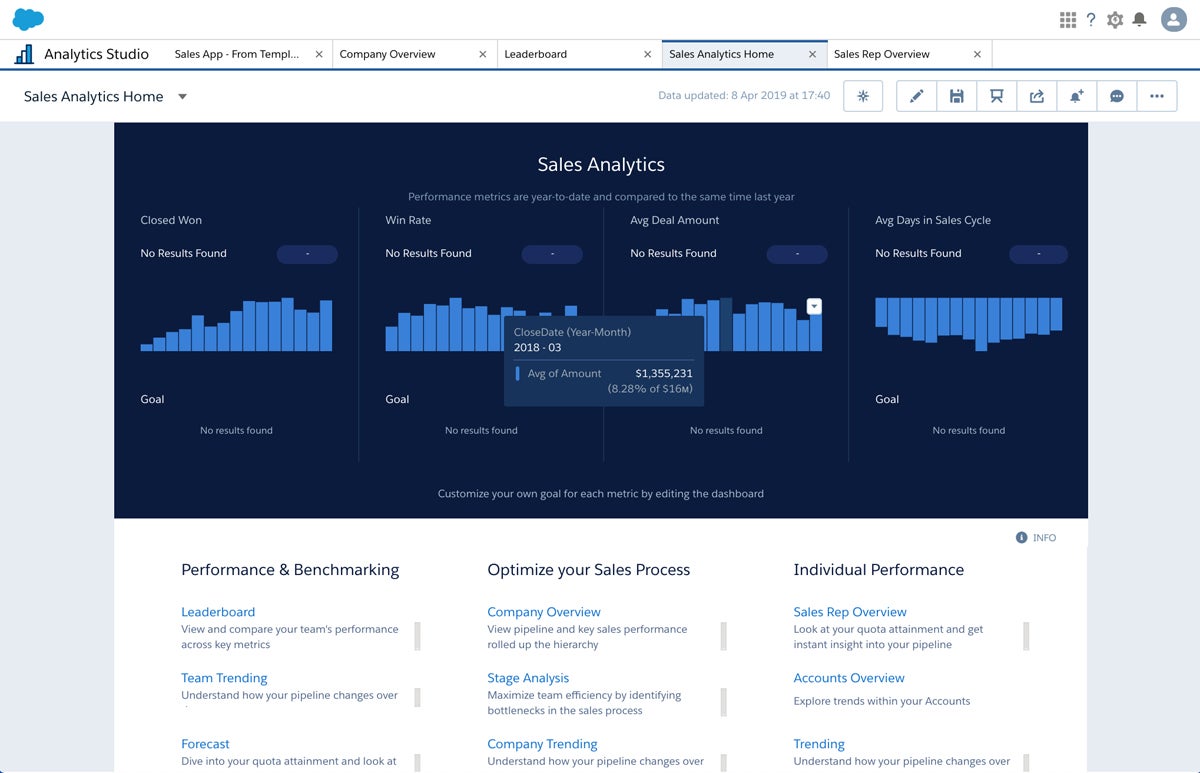
Pros and Cons
| Pros | Cons |
|---|---|
| Offers a discovery and analytics studio that lets you build AI-powered apps from scratch or with prebuilt templates | Customization options can be improved |
| Integrated with workflow automation tools | Generating reports requires deeper knowledge |
| Natural language processing |
Pricing
- Einstein Predictions: $75 per user per month, billed annually.
- CRM Analytics Growth: $140 per user per month, billed annually.
- CRM Analytics Plus: $165 per user per month, billed annually.
- Revenue Intelligence: $220 per user per month, billed annually.
Features
- Data management capabilities such as visual data prep and self-contained ETL functionality.
- No code AI with predictive and prescriptive analytics capabilities.
- Real-time recommendations.
- Automated discovery.
- Narrative explanations and natural language generation capabilities.
For a fuller understanding of how AI tools are used, see our guide: Top Generative AI Apps and Tools
IBM Cognos Analytics: Best for Self-Service Analytics
IBM Cognos Analytics is an AI-charged, self-service analytics platform. The IBM Cognos Analytics self-service capabilities empower credentialed users to access and manipulate reports on mobile devices – without needing an admin – even offline or in disconnected environments. Its guided self-service approach can predict user intent and provide recommendations while automating the analytics process.
Cognos Analytics also offers natural language search and AI-assisted analytics, allowing users to ask questions in plain language and receive intelligent insights. You can also use the Cognos Analytics AI-assisted data module to add calculated fields, join data sources, and create custom datasets for your team.
The Cognos Analytics platform offers many features, including data integration and modeling, advanced analytics, data visualizations, reporting, and dashboarding. It allows you to connect with external data sources and supports data from various sources, including databases, spreadsheets, cloud storage, and big data.
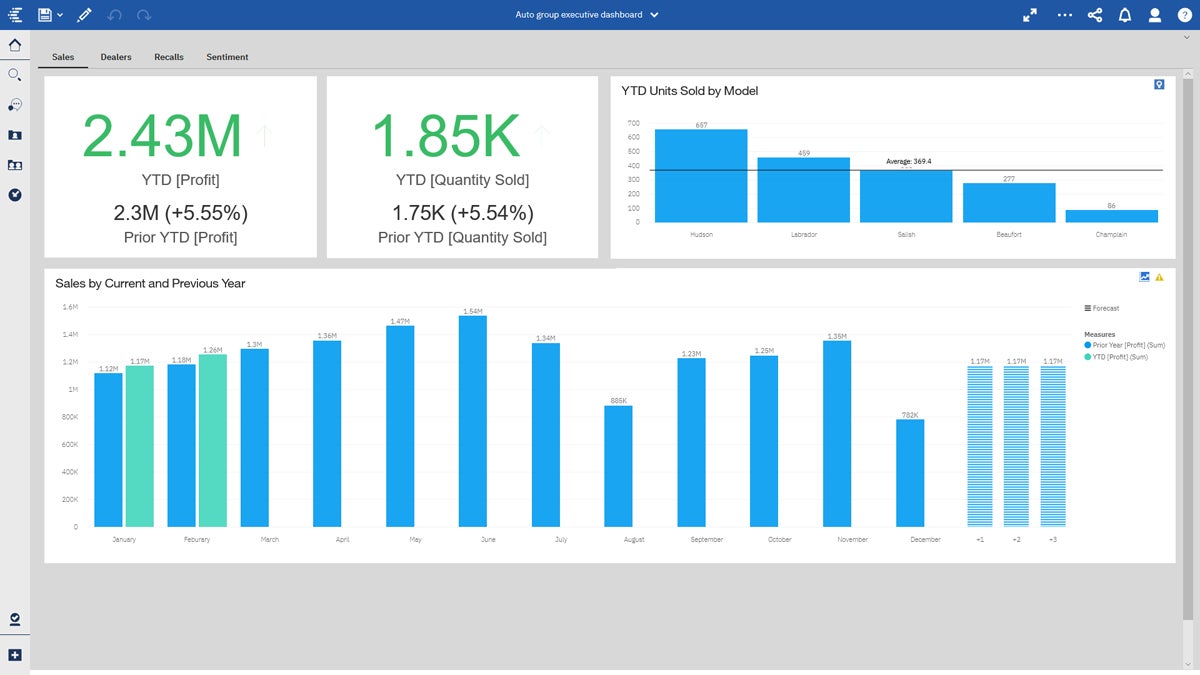
Pros and Cons
| Pros | Cons |
|---|---|
| Easy to learn and use | Error messages are not usually very clear |
| Able to perform complex data analysis tasks in real-time | Pricing is on the high side |
| Comprehensive BI package |
Pricing
Free trial for up to 5 users.
- Cognos Analytics on Cloud On-Demand: The Standard user plan starts at $10.60 per user per month, while the Premium user plan starts at $42.40 per user per month.
- Cognos Analytics on Cloud Hosted: Custom quote.
- Cognos Analytics software: Custom quote.
Features
- Real-time analysis.
- Automate data exploration.
- Visualize and report on data.
- Web-based data modeling — Upload, connect to, join, and model your data.
- Data exploration and prediction — predictive forecasting, decision trees, AI assistant.
Sisense: Best for Product Teams
Featuring pro-code, low-code, and no-code capabilities, Sisense is a business intelligence solution that allows product teams to extract data from various sources to generate AI/ML-driven analytics and insights that can be integrated into applications.
Business users can leverage Sisense’s no/low code applications, while engineers can use their developer-first tools with SDKs and APIs to build and customize advanced analytics applications. These can be embedded into your organization’s product UI and the CI/CD pipeline.
Improving productivity, end users can visualize AI/ML-augmented analytics with charts and graphs or explore the data through natural language query (NLQ)-interpreted questions and natural language generation (NLG) or generative AI-created answers.
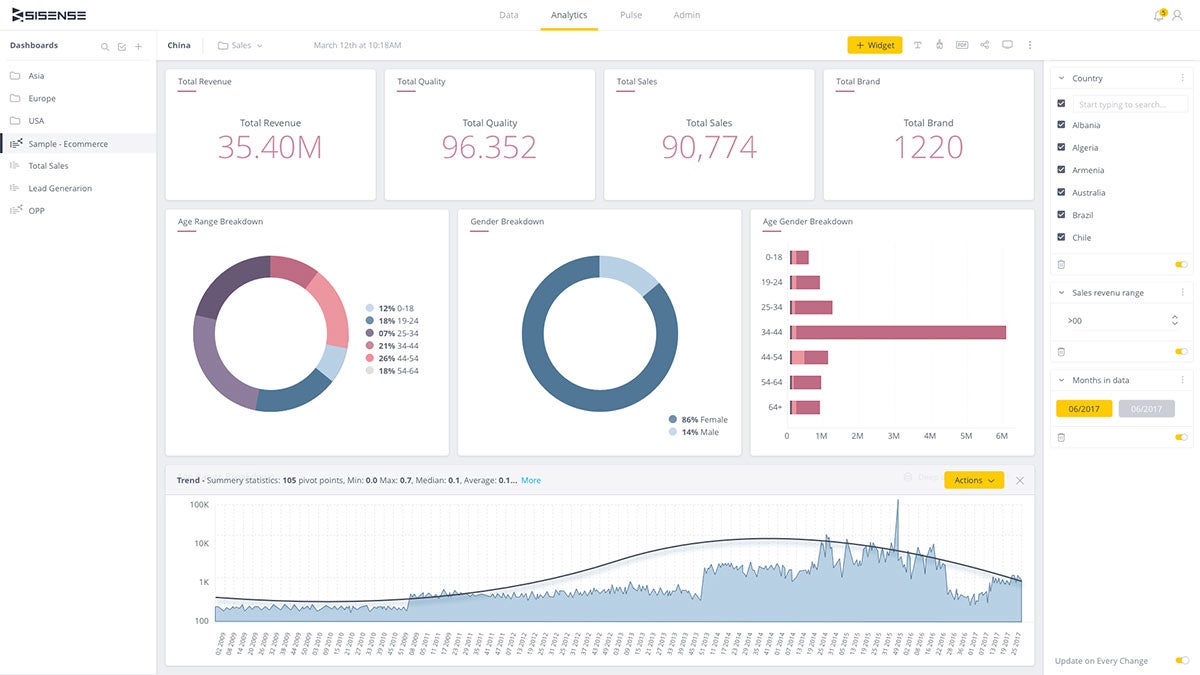
Pros and Cons
| Pros | Cons |
|---|---|
| Solid NLQ and NLG capability | Lack transparent pricing |
| Responsive customer support team and active community forum | Occasional steep learning curve— especially for new users or with the release of new features |
| Extensive documentation and resource library |
Pricing
Though Sisense doesn’t advertise its rates on its website, publicly available data shows that the AI data tool’s costs are as follows:
- Sisense Essentials package: $40,000 for 12 months, $80,000 for 24 months, or $120,000 for 36 months.
- Sisense Advanced package: $69,000 for 12 months, $138,000 for 24 months, or $207,000 for 36 months.
- Sisense Pro package: $109,000 for 12 months, $218,000 for 24 months, or $327,000 for 36 months.
For your actual rate, contact the company for a custom quote.
Features
- Data visualization.
- Flexible deployment options – Sisense works with cloud, on-premises, and hybrid architectures.
- Data storytelling using charts, graphs, maps, and summaries.
- Generative AI capability.
Qlik Analytics Platform: Best for Data Exploration
The Qlik Analytics Platform, which includes Qlik Cloud Analytics and Qlik Sense, is a top AI data analytics software that combines the capabilities of BI and data visualization to enable you to analyze your data. Qlik Cloud Analytics allows you to deploy its analytics on the cloud, making it accessible from anywhere, while Qlik Sense is designed for on-premise deployment, catering to industries with strict regulations regarding data privacy and security.
Qlik stands out for its data exploration capabilities, as it allows both technical and non-technical users to discover insights and patterns in their data through interactive visualizations. Its drag-and-drop editors can also help teams with their workflow as it lets them investigate their data – to a very detailed extent – and create customized visualizations and reports.
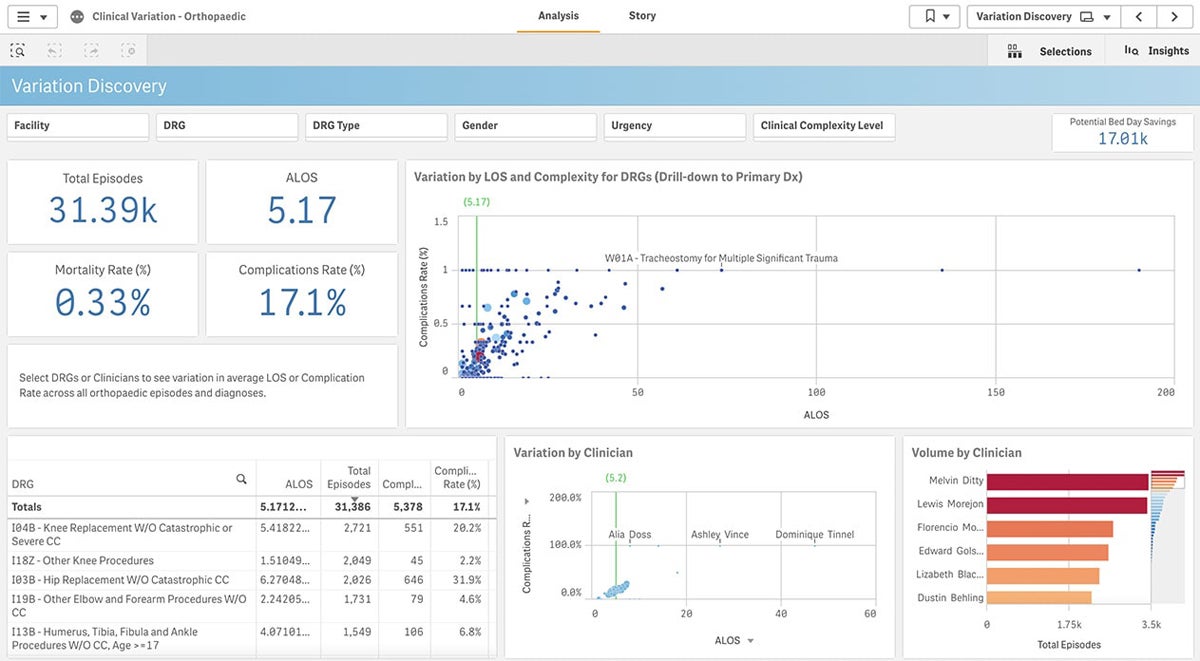
Pros and Cons
| Pros | Cons |
|---|---|
| Provides alerts for data changes | The standard plan has limited storage capacity |
| AI-generated analyses and insights | |
| Search and natural language interaction | |
| It can automatically distribute reports in formats like PDF, PPT, and Excel |
Pricing
Qlik Cloud Analytics plans and pricing are as follows:
- Standard: $20 per user per month, billed annually. Minimum of 10 users and up to 50GB data for analysis capacity (annual).
- Premium: $2,700 per month, billed annually. It starts at 10 full users and 50 GB of data per year for analysis.
- Enterprise: Custom quote. Starts at 500GB data for analysis capacity (annual).
Features
- Interactive data visualizations and dashboards.
- AI-generated analyses and insights, including search and natural language interaction.
- Integration with third-party data science and machine learning tools like Amazon Sagemaker and Comprehend, Azure ML, and connectivity for custom solutions built in languages such as R and Python.
- Reporting and alerting capabilities.
- Capable of generating analyses through machine learning, predictive analytics, and generative AI.
Splunk: Best for Big Data Management and Analysis of Machine Data
Though many users know Splunk as a security information and event management (SIEM) tool, it goes beyond that. Splunk also offers tools for data analysis that incorporate AI. Splunk Enterprise collects, indexes, and analyzes machine-generated data in real time. It provides search capabilities that enable you to search through large volumes of data. You can search for specific data, perform complex queries, and create reports and visualizations.
One of the standout features of Splunk Enterprise is its ability to ingest and index data from various sources, including logs, metrics, and other machine-generated data – these integrated data tools enable great facility with big data management and analysis of machine learning data sets.
Splunk can handle structured and unstructured data, making it an excellent choice for organizations with diverse data sources. To that end, Splunk collects data from various systems, including websites, applications, sensors, and devices, to monitor business metrics and investigate specific results.
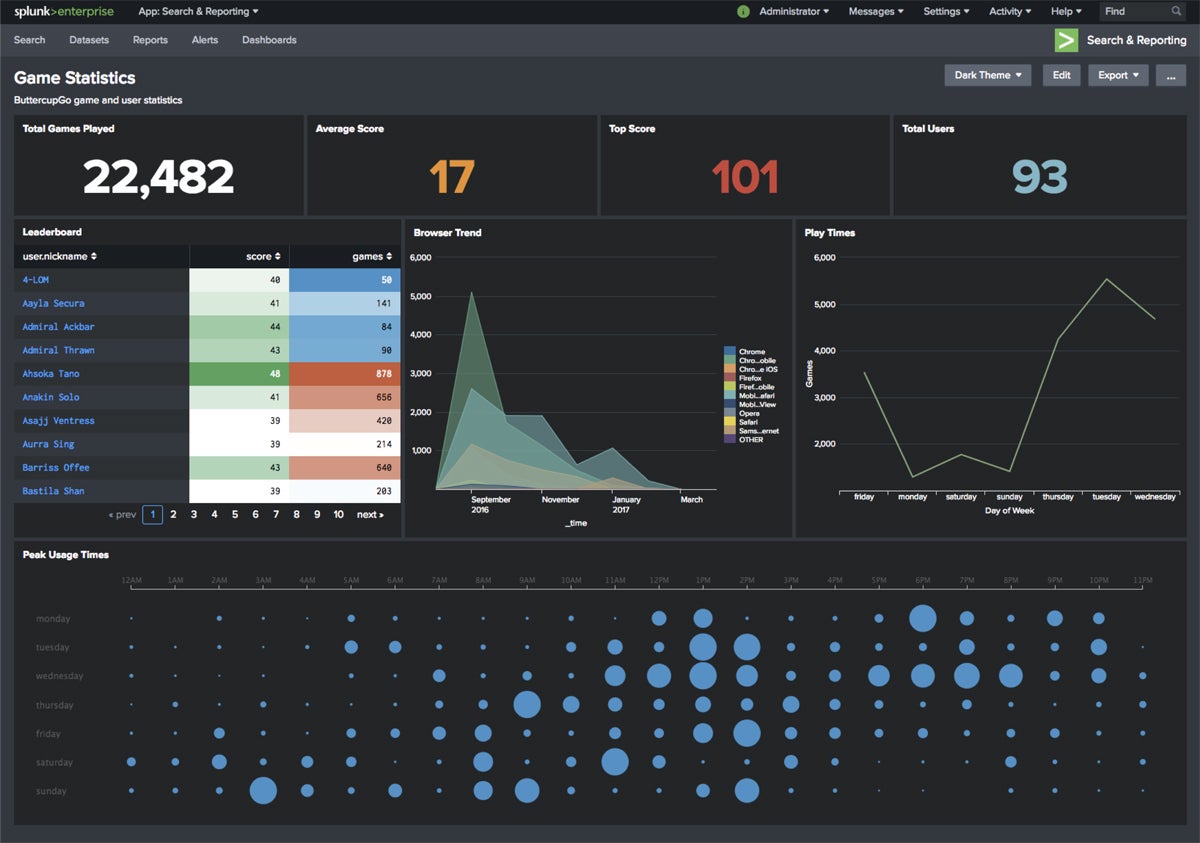
Pros and Cons
| Pros | Cons |
|---|---|
| Good for security and observability | Users say the tool is pricey |
| Performance metrics | Steep learning curve |
| Allows you to visualize and analyze data in real-time | Lack transparent pricing |
| Capable of processing large amounts of data |
Pricing
Splunk doesn’t advertise its rates on its website. Contact the company for a custom quote.
Features
- Real-time data stream processing.
- It integrates with over 2,300 third-party apps, including AWS, GCP, Microsoft Azure, SAP, Kafka, OpenShift, Kubernetes, and more.
- Dashboards and visualizations.
- Monitoring and alerting.
Looker: Best for Data Visualization
Looker is a platform for BI, data applications, and embedded analytics that allows users to explore and analyze data from different sources. It offers data exploration, transformation, and data visualization tools, allowing non-technical and technical professionals to access and analyze data.
Its data visualization functionality is particularly strong, as Looker’s toolset includes a drag-and-drop interface, advanced filtering and data manipulation capabilities, and collaborative tools for sharing dashboards and reports – of which help create visually appealing data reports. Looker’s integration capabilities enable it to connect these reports with a wide variety of data sources and applications.
Depending on learning style, some businesses professionals find it’s easier to digest these visual reports and so make fast, data-backed decisions.
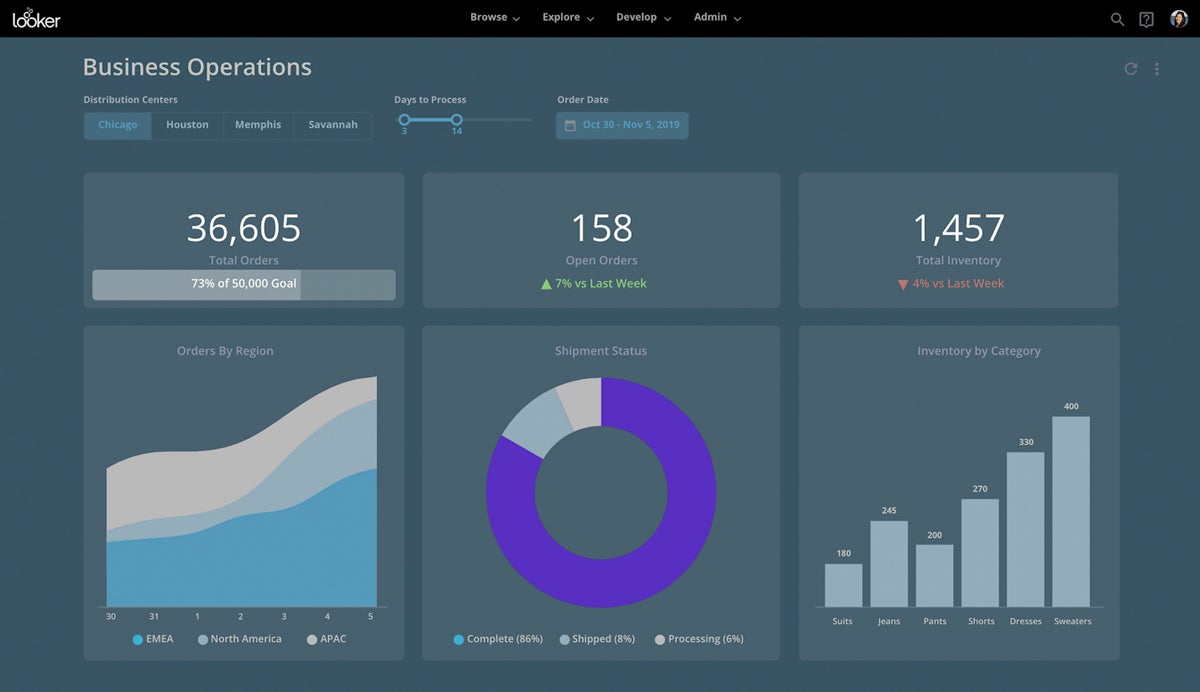
Pros and Cons
| Pros | Cons |
|---|---|
| Collaborative features | Looker’s pricing can be prohibitive for smaller businesses |
| Comprehensive data modeling capability | Initial configuration can take some time |
| Support data exploration |
Pricing
Looker has two pricing components: Platform and user pricing.
Platform pricing is the cost of running a Looker instance, and user pricing is the price of licensing individual users to access the Looker platform.
Platform editions:
- Standard edition: Starts at $5,000 per month. Ideal for teams with fewer than 50 users.
- Enterprise: Custom quotes.
- Embed: Custom quotes.
User licensing:
- Viewer user: $30 per user per month.
- Standard user: $60 per user per month.
- Developer user: $125 per user per month.
Features
- Looker can be easily embedded into other applications.
- Offers integrations with various data sources, including databases, data warehouses, and cloud storage solutions.
- Visualization – you can create charts, graphs, and dashboards that are highly customizable and interactive.
- Automatic data model generation that scans data schemas.
To explore a larger array of data visualization tools, see our guide: Top Data Visualization Tools
ThoughtSpot: Best for Performing Search-Driven Analytics
Artificial intelligence and automation are the core components of the ThoughtSpot data analytics solution. Most notably, the company aims to democratize access to data and analytics by simplifying the process and making it accessible to all users, regardless of their technical expertise. The platform uses AI to understand the user’s intent, analyze large amounts of data, and provide relevant real-time insights and visualizations.
To support its mission of democratizing data access, ThoughtSpot’s search-driven analytics tool allows you to ask questions using natural language and receive instant and relevant insights through visualizations and reports. The platform uses AI and machine learning algorithms to understand user queries and provide accurate answers.
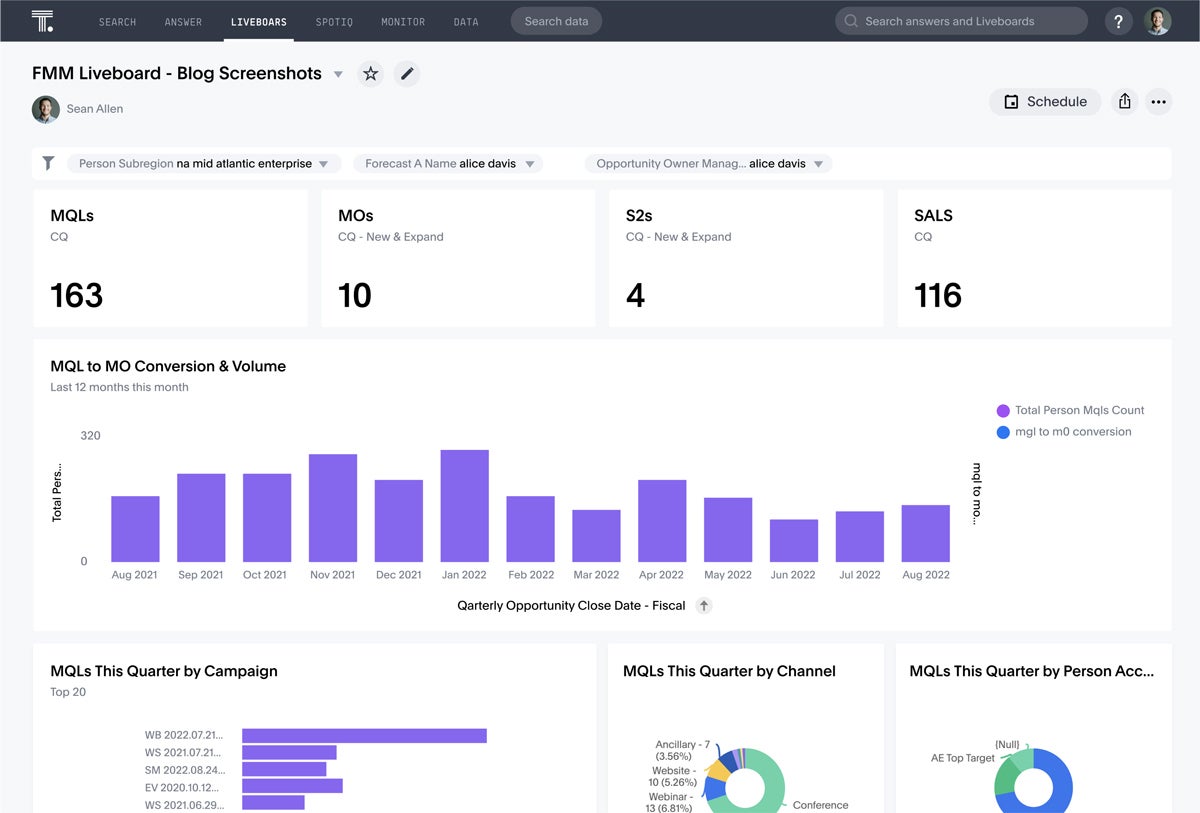
Pros and Cons
| Pros | Cons |
|---|---|
| AI-driven automation | Limited support for Team and Essentials plan subscribers |
| Allows you to use search to create charts and curate your own data stories | Costly for small businesses |
| Self-service analytics |
Pricing
- Team: $95 per month for up to five users.
- Essentials: $15,000 per year — for up to 20 users.
- Pro: Custom quote. Billed yearly. Unlimited users.
- Enterprise: Custom quote. Billed annually. Unlimited users.
Features
- Its AI-powered search lets you ask questions in natural language and get AI-powered answers to your questions.
- Support various cloud platforms, including Google BigQuery, Amazon Redshift, Oracle, and more.
- Embedded liveboards, charts, and tables.
- Natural language search.
- Drill-down analysis.
Polymer: Best for Agencies, eCommerce, and Marketing Teams
Polymer’s AI data analysis platform enables you to create visualizations, build dashboards, and present data insight interactively. It offers AI data analytics tools designed particularly for agencies, eCommerce businesses, and marketing teams looking to leverage data analytics to drive their strategies.
Polymer offers an automated eCommerce reporting platform, enabling you to monitor your Shopify and Amazon business performance metrics. You can also leverage AI to generate automated digital sales reports. This allows you to gather and consolidate data from multiple sources, providing a comprehensive view of your marketing performance.
To further support marketers, Polymer offers several eCommerce BI templates, including SEO reports, Facebook Ads reports, and PPC reports. Polymer automates client reporting processes for agencies, allowing you to create individual workspaces for each client and generate shareable reports and insights.
You can connect Polymer with a wide array of third-party tools, including Google Ads, Excel, Sheets, Zendesk, and Shopify.
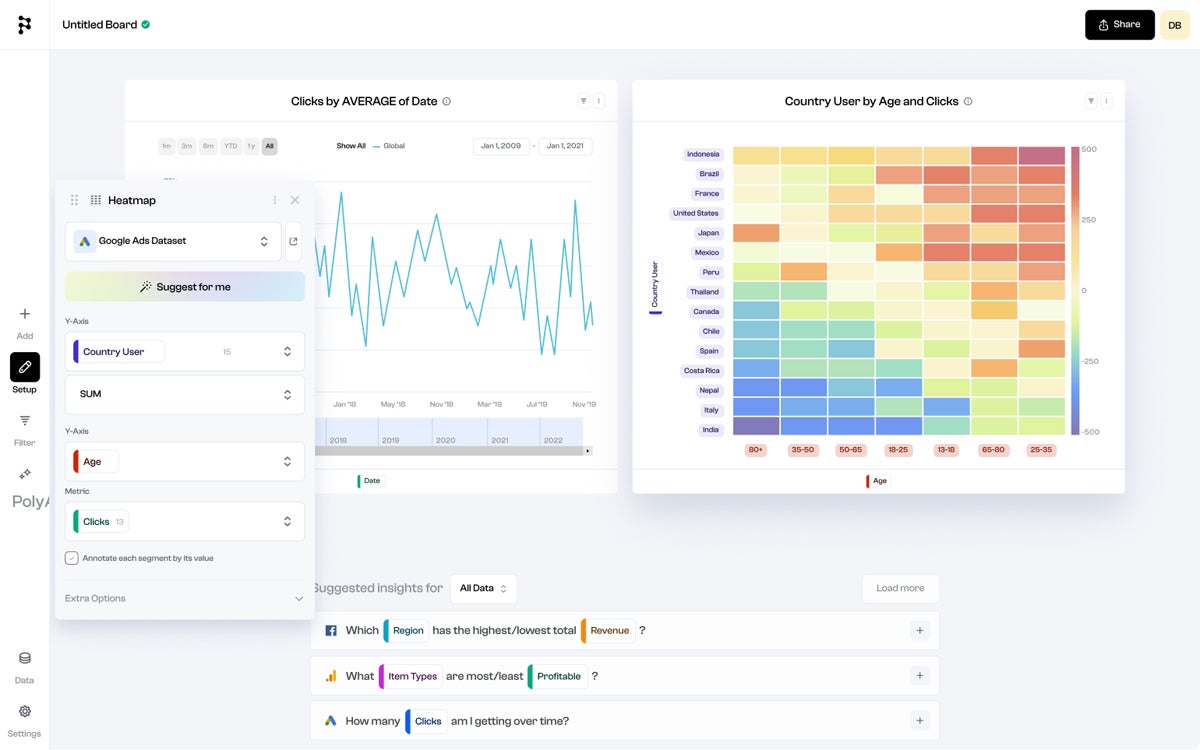
Pros and Cons
| Pros | Cons |
|---|---|
| Offers 20+ dashboard templates | Limited integration |
| Data visualizations |
Pricing
14-day free trial available.
- Starter: $20 per user per month, billed monthly or $10 per user per month, billed annually.
- Pro: $40 per user per month, billed monthly or $20 per user per month, billed annually.
- Group/Enterprise: Custom quote.
Features
- Connect with numerous data sources.
- Support embedded analytics.
- Offers numerous data visualization widgets, including heatmaps, line charts, pie charts, scatter plots, and more.
How to Choose the Best AI Data Analytics Software for Your Business
Finding the best AI data analytics software can be daunting and overwhelming, as the process requires extensive research, which is usually time-consuming. It typically includes booking several demos and attending numerous meetings with AI data analytics vendors.
We have researched the sector for you and found the top AI data analysis tool for different types of businesses. For instance, our research found that Looker is ideal for data visualization, while Salesforce is well suited for CRM analytics. Splunk is suitable for big data management, and IBM Cognos Analytics is the best option for those looking for a self-service AI data analytics tool.
Sisense is best for product teams, Qlik is ideal for data exploration, and ThoughtSpot is suitable for performing search-driven analytics. Business users, agencies, eCommerce, and marketing teams may find Polymer’s features beneficial to their workflow.
When shopping for the best AI data analysis software, you need to identify your data analysis needs, consider your industry, and evaluate each tool’s core capabilities to ensure it aligns with your business needs.
AI Data Analytics Software: Frequently Asked Questions (FAQs)
We answered the most commonly asked questions about AI data analytics software and tools to help you discover the most suitable solution for your company.
What key features should I look for when selecting AI data analytics software?
- Data visualization, for easily understood reporting.
- Machine learning capabilities, to automate reporting.
- Natural language processing, so users can speak their queries in everyday language.
- Mobile compatibility, for use on the go.
- Data security, to protect sensitive corporate data.
- Collaboration features, so teams can work together.
- Customization options, to allow you to set parameters based on your needs.
Can AI data analytics tools handle large and complex datasets efficiently?
AI data analytics software can process and analyze massive and complex datasets. The tools can handle structured, unstructured, and semi-structured data, extracting insights and patterns from different sources.
How do AI analytics solutions contribute to better decision-making in business?
AI data analytics enhance decision-making in many ways. Some of these include:
- Speed and efficiency.
- Risk management.
- Greater accuracy and objectivity.
- Real-time decision support.
- Process optimization.
- Identification of complex patterns.
Bottom Line: AI Data Analytics Software & Tools
Before now, data analytics tasks were reserved for data practitioners; as AI becomes commonplace, business/non-technical individuals can now create dashboards for data visualization and advanced data querying. AI enables users to perform data analytics functions by communicating with the system using natural language processing.
This generational change in data analytics allows for quicker and easier access to data insights, enabling decision-makers to make data-driven decisions without relying on technical experts.
To learn more about how AI software is used in the enterprise, read our in-depth guide: Best Artificial Intelligence Software
